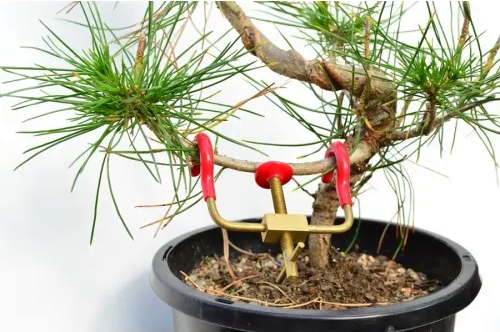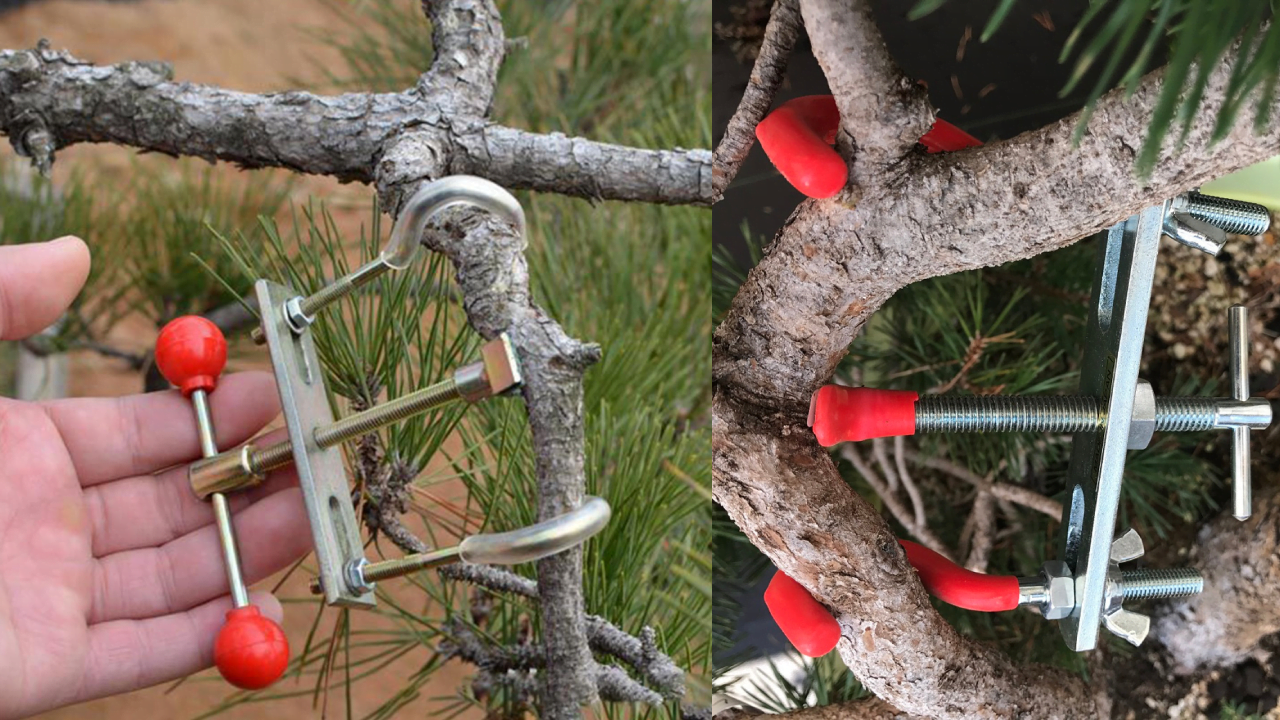Bonsai branch bender is a must-have tool for bonsai lovers. This small device lets you gently bend branches into whatever shape you want.
Although it may seem like a small tool, a bonsai branch bender can make bonsai techniques much more interesting and creative.
In this article, I will show you how bonsai branch benders improve your bonsai tree and how to use them.
What is Bonsai Branch Bender?

A bonsai branch bender is a specialized tool used to shape and bend branches of bonsai trees. It consists of two metal arms for holding and manipulating branches. Using the tool, you can apply varying degrees of pressure to the branch to shape or bend it precisely.
How a Bonsai Branch Bender Enhances Your Bonsai Techniques
In the following ways, you can enhance your bonsai tree with the bonsai bender technique:
- Using a bonsai branch bender, you can bend branches exactly how you want. With this precision, the branch is bent exactly the way you want it, so you get the perfect tree look.
- Additionally, it minimizes the stress on the trunk of the tree. Because you’re manipulating the branch directly, not bending the trunk. As a result, the tree is healthier and less prone to damage.
- With a branch bender, you can bend branches that would otherwise be too stiff or inflexible. With this increased flexibility, you can do more creative stuff.
- You can save time by using a bonsai branch bender as it allows you to get the shape you want faster and more accurately.
- The use of a branch bender will make your tree healthier, more attractive, and more unique.
How to Bend Bonsai Trunk?
You can bend bonsai trunks by following these steps:
Step #1: Prepare your bonsai tree
By setting up your tree in advance, you will make bending a lot easier. This will also increase your chances of success.
Take your tree out of the house for one day and let it sizzle. It is important to remember that a newly irrigated tree will easily break if bent.
During sizzling, the trunk becomes more bendable, which reduces the chance of it breaking.
In order to test it, you can drench it in water and then bend it. Once it has been overlooked for a moment, do it again.
Step #2: Choose the right wire size
To bend a bonsai tree, you can use any kind of wire. It’s all about bending the trunk, so any method is fine. However, aluminum and copper wire set the standard.
The first thing you need to decide is whether the wire is thick enough to do the job. If you want to bend the tree trunk, you need the right wire size. Also, it’s important to understand the risks of using inappropriate wire sizes. As it’s impossible to hold a trunk with wires that are too small.
If needed, you can put two wire bruises next to each other. Basically, you use a wire one-third the diameter of the trunk. Also, make sure the other end is firmly embedded in the soil at the trunk’s base if you are just using a hollow dish.
Put one hand on the wire, and firmly hold it to the trunk’s base. With your other hand, coil the wire 45 degrees. Every turn, move the hand that’s stretching the wire up so it follows the spiral up the trunk as it entwines.
Connect the trunk to the wire to help you decide which wire to use. If the trunk gets really slim with the wire you’re using, switch to a larger strand. Before you get to the top, trail the wider wire up the bonsai trunk for a minimum of two turns.
Step #3: Set up the wire base
At the base of the trunk, embed the wire through an angle of 45 degrees around 2-3 inches into the soil. Hold the wire in place in the soil, and wrap a compact coil (45 degrees) around the base of the trunk. Do this firmly, leaving no gaps between the trunk and the wire.
Step #4: Wire up the trunk
Continue wrapping the wire at 45 degrees beside the trunk until you get to the edge at the high point. Be sure to secure the 45-degree angle when bending the trunk.
Once you’ve reached the top, you can cut the wiring once the trunk starts to dwindle. If any wire goes over, close it off.
Following are some most common wiring mistakes:
- A wire is really close to the trunk, so it’ll stop the sap flow and make the trunk not die.
- A wire is super open, and can’t hold enough power.
- There’s no impact on the wire because it’s so unconstrained.
Step #5: Cut off the excess wire
When you get close to the apex, you can close off the excess wire. With a bonsai wire cutter, you can get rid of the wire securely without damaging the trunk.
Step #6: Organize trunks
Tighten your wrists. Use your forearms to bend your trunk. When you get close to the high point of your trunk, make more compact and denser bends.
Using two hands, bend the trunk with your thumbs serving as support. Approach the top, the shapes should be more confined. Remember, a tree is described as three-dimensional, so it must be bent backward and forward proportionally.
It might work to make bends with a single even motion, but constant re-alteration will damage the bark.
You may also want to consider Jin Pliers if you’re engaging with a wider trunk. This is a more radical method where you bend the trunk with two pliers.
Step #7: Let the trunk set up
Once you’re done bending the trunk, you have to wait 3-4 months for the wire to set before you can remove it. When the trunk starts wearing away into the wire, it’s time to take it out.
Step #8: Aftercare
As the tree grows, branches will grow around the wires, damaging the bark and leaving permanent scars. So, make sure you take the wires out before they dig into the bark.
If you’re taking out wiring, you should cut every wire you come across. Also, don’t try to recycle wire by unwinding it from branches. You’ll probably damage the tree if you unwind it.
Conclusion
Any bonsai enthusiast looking to enhance their bonsai techniques needs a bonsai branch bender. With this tool, you can bend and shape branches with precision, minimize trunk stress, and save time. Furthermore, a branch bender will add health and beauty to your tree.
It is crucial to follow the proper steps when bending bonsai trunks, including preparing the tree, picking the right wire size, assembling the wire base, wiring up the trunks, cutting off excess wires, organizing the trunks, and letting them set up.
You can create a striking and unique bonsai tree that will be the envy of all who see it by following the above steps and using a bonsai branch bender.
Related Articles
- Bonsai Bloom Booster: How Beer and Garlic Will Change Your Gardening Game!
- Bonsai for Beginners in India [Update 2024]
- Elevate Your Collection: 11 Breathtaking Bonsai Species You Can’t Resist
- 9 Things You Must Stop Doing As a Bonsai Owner To Make Your Bonsai Live Longer
- How To Select Bonsai Accent Plants- an ultimate guide to bonsai accent plants
- Top 15 Benefits of Bonsai Plants that will Make your Life Awesome





